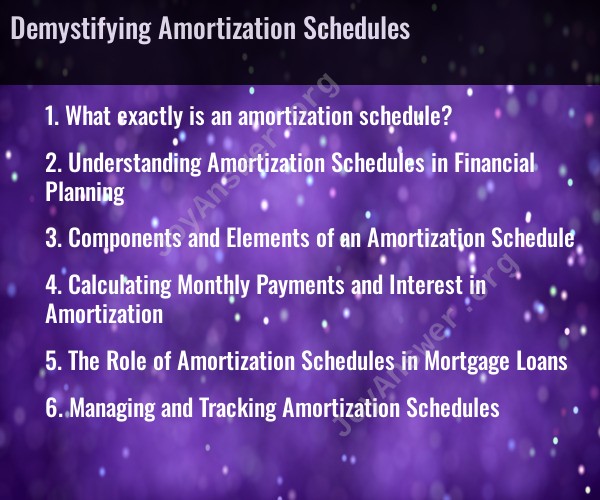What exactly is an amortization schedule?
An amortization schedule is a detailed table or chart that outlines the periodic payments on a loan or mortgage, breaking down each payment into its principal and interest components. This schedule provides a comprehensive overview of how the loan balance decreases over time as payments are made.
Here are the key components of an amortization schedule:
Payment Number (or Period): Each row in the schedule represents a specific payment period, typically on a monthly basis, but it can be adjusted for different intervals, depending on the loan terms.
Payment Amount: This is the total amount you pay each period, which includes both the principal and interest portions. The payment remains relatively consistent throughout the loan term if you have a fixed-rate loan.
Principal Payment: This portion of the payment goes toward reducing the outstanding loan balance. Over time, the principal payment increases, while the interest payment decreases.
Interest Payment: The interest payment is the cost of borrowing money. It decreases over time as the outstanding balance decreases.
Total Interest Paid: The total interest paid column shows the cumulative interest payments made over the life of the loan. It highlights the total cost of borrowing the money.
Outstanding Balance: This column shows the remaining loan balance after each payment. It decreases with each payment as you pay down the principal.
Amortization schedules are particularly common for mortgage loans, car loans, and personal loans. They serve several purposes:
Transparency: Amortization schedules provide borrowers with a clear understanding of how their loan works and how payments are applied to principal and interest.
Budgeting: The schedule helps borrowers plan their budgets by showing how much they need to allocate for loan payments each month.
Debt Management: Borrowers can use the schedule to track their progress in paying down their loans and to decide if they want to make extra payments or refinance their loans.
Interest Calculation: Lenders use amortization schedules to calculate the interest portion of each payment and to track the repayment of the principal.
Tax Planning: For some types of loans, such as mortgages, the interest paid may be tax-deductible. The amortization schedule helps borrowers determine their tax deductions accurately.
Amortization schedules are valuable tools for both borrowers and lenders, as they provide a clear breakdown of the repayment process, helping borrowers make informed financial decisions and manage their debt effectively.
Sure, here's a comprehensive explanation of the five topics you mentioned:
Understanding Amortization Schedules in Financial Planning
An amortization schedule is a table that details the gradual repayment of a loan over time through regular payments. It outlines the breakdown of each payment into principal and interest components, providing a clear picture of the loan's repayment structure and overall cost. Amortization schedules play a crucial role in financial planning, particularly when managing long-term debt like mortgages or car loans.
Components and Elements of an Amortization Schedule
A standard amortization schedule typically includes the following components:
Loan Amount: The original amount borrowed.
Interest Rate: The percentage charged on the outstanding loan balance.
Loan Term: The total duration of the loan, typically expressed in years or months.
Payment Frequency: The frequency of payments, usually monthly or quarterly.
Payment Number: The sequential number of each payment.
Beginning Balance: The outstanding loan balance at the start of the payment period.
Monthly Payment: The fixed amount paid each period.
Principal Paid: The portion of the payment applied to reducing the loan balance.
Interest Paid: The portion of the payment that covers the interest accrued on the outstanding loan balance.
Ending Balance: The remaining loan balance after each payment.
Calculating Monthly Payments and Interest in Amortization
The monthly payment amount can be calculated using the loan amount, interest rate, and loan term. There are various formulas and online calculators available to determine the monthly payment.
Once the monthly payment is known, the principal and interest components can be calculated for each payment period. The principal paid for each period is fixed and remains constant throughout the loan term. The interest paid, however, decreases as the loan balance reduces.
The Role of Amortization Schedules in Mortgage Loans
Amortization schedules are particularly important for mortgage loans, which typically have longer terms and higher loan amounts. These schedules provide homeowners with a clear understanding of their monthly payments, the distribution of principal and interest, and the overall cost of the loan over its lifetime.
Amortization schedules also help homeowners plan for future expenses, such as property taxes and homeowners insurance, and make informed decisions about refinancing or early repayment options.
Managing and Tracking Amortization Schedules
Homeowners can manage and track their amortization schedules using various methods:
Lender-provided schedules: Most lenders provide borrowers with amortization schedules at the time of loan origination.
Online loan portals: Many lenders offer online portals where borrowers can access their loan information, including amortization schedules.
Amortization calculators: Online amortization calculators can be used to generate schedules for any loan amount, interest rate, and term.
Personal spreadsheets: Creating a personal spreadsheet can provide a customized way to track and manage amortization data.
By regularly reviewing amortization schedules, homeowners can stay informed about their loan progress, make informed financial decisions, and plan for future expenses associated with their mortgage.












